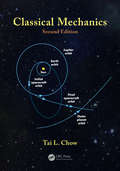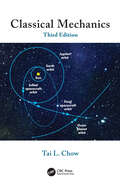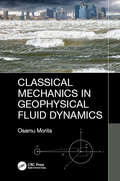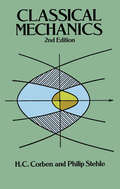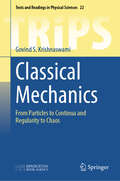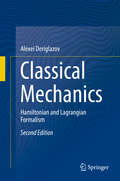- Table View
- List View
Classical Field Theory: On Electrodynamics, Non-abelian Gauge Theories And Gravitation (Graduate Texts in Physics)
by Florian ScheckScheck’s successful textbook presents a comprehensive treatment, ideally suited for a one-semester course. The textbook describes Maxwell's equations first in their integral, directly testable form, then moves on to their local formulation. The first two chapters cover all essential properties of Maxwell's equations, including their symmetries and their covariance in a modern notation. Chapter 3 is devoted to Maxwell's theory as a classical field theory and to solutions of the wave equation. Chapter 4 deals with important applications of Maxwell's theory. It includes topical subjects such as metamaterials with negative refraction index and solutions of Helmholtz' equation in paraxial approximation relevant for the description of laser beams. Chapter 5 describes non-Abelian gauge theories from a classical, geometric point of view, in analogy to Maxwell's theory as a prototype, and culminates in an application to the U(2) theory relevant for electroweak interactions. The last chapter 6 gives a concise summary of semi-Riemannian geometry as the framework for the classical field theory of gravitation. The chapter concludes with a discussion of the Schwarzschild solution of Einstein's equations and the classical tests of general relativity. The new concept of this edition presents the content divided into two tracks: the fast track for master's students, providing the essentials, and the intensive track for all wanting to get in depth knowledge of the field. Cleary labeled material and sections guide students through the preferred level of treatment. Numerous problems and worked examples will provide successful access to Classical Field Theory.
Classical Guitar Design
by Giuseppe Cuzzucoli Mario GarroneThis book describes the entire process of designing guitars, including the theory and guidelines for implementing it in practice. It discusses areas from acoustics and resonators to new tools and how they assist traditional construction techniques. The book begins by discussing the fundamentals of the sounds of a guitar, strings, and oscillating systems. It then moves on to resonators and acoustics within the guitar, explaining the analysis systems and evaluation methods, and comparing classic and modern techniques. Each area of the guitar is covered, from the soundboard and the back, to the process of closing the instrument. The book concludes with an analysis of historic and modern guitars. This book is of interest to luthiers wanting to advance their practice, guitar players wishing to learn more about their instruments, and academics in engineering and physics curious about the principles of acoustics when applied to musical instruments.
Classical Kinetic Theory of Weakly Turbulent Nonlinear Plasma Processes
by Peter H. YoonKinetic theory of weakly turbulent nonlinear processes in plasma helped form the foundation of modern plasma physics. This book provides a systematic overview of the kinetic theory of weak plasma turbulence from a modern perspective. It covers the fundamentals of weak turbulence theory, including the foundational concepts and the mathematical and technical details. Some key obstacles to space plasma applications are also covered, including the origin of non-thermal charged particle population, and radio burst phenomena from the sun. Treating both collective and discrete particle effects, the book provides a valuable reference for researchers looking to familiarize themselves with plasma weak turbulence theory.
Classical Mechanics
by Artemio González–LópezClassical Mechanics is a textbook for undergraduate students majoring in Physics (or Mathematics and Physics). The book introduces the main ideas and concepts of Newtonian, Lagrangian, and Hamiltonian mechanics, including the basics of rigid body motion and relativistic dynamics, at an intermediate to advanced level. The physical prerequisites are minimal, with a short primer included in the first chapter. As to the mathematical prerequisites, only a working knowledge of linear algebra, basic multivariate calculus, and the rudiments of ordinary differential equations is expected.Features Numerous exercises and examples A focus on mathematical rigor that will appeal to Physics students wanting to specialize in theoretical physics, or Mathematics students interested in math- ematical physics Sufficient material to service either a one- or two-semester course
Classical Mechanics
by John R. TaylorThis book is intended for students of the physical sciences, especially physics, who have already studied some mechanics as part of an introductory physics course ("freshman physics" at a typical American university) and are now ready for a deeper look at the subject. John Taylor has brought to his new book, Classical Mechanics, all of the clarity and insight that made his introduction to Error Analysis a best-selling text.
Classical Mechanics
by Martin W. MccallThis new edition of Classical Mechanics, aimed at undergraduate physics and engineering students, presents ina user-friendly style an authoritative approach to the complementary subjects of classical mechanics and relativity.The text starts with a careful look at Newton's Laws, before applying them in one dimension to oscillations and collisions. More advanced applications - including gravitational orbits and rigid body dynamics - are discussed after the limitations of Newton's inertial frames have been highlighted through an exposition of Einstein's Special Relativity. Examples given throughout are often unusual for an elementary text, but are made accessible to the reader through discussion and diagrams.Updates and additions for this new edition include:New vector notation in Chapter 1An enhanced discussion of equilibria in Chapter 2A new section on a body falling a large distance towards a gravitational source in Chapter 2New sections in Chapter 8 on general rotation about a fixed principal axes, simple examples of principal axes and principal moments of inertia and kinetic energy of a body rotating about a fixed axisNew sections in chapter 9: Foucault pendulum and free rotation of a rigid body; the latter including the famous tennis racquet theoremEnhanced chapter summaries at the end of each chapterNovel problems with numerical answersA solutions manual is available at: www.wiley.com/go/mccall
Classical Mechanics
by Tai L. ChowEmphasizing a modern perspective, this book presents a complete account of the classical mechanics of particles and systems for physics students at the advanced undergraduate level. This edition has been updated with two new sections and three new chapters as well as four new appendices. The text assumes readers have been exposed to courses in calculus and calculus-based general physics, while no prior knowledge of differential equations is required. Each chapter contains homework problems of varying degrees of difficulty to enhance understanding of the material in the text.
Classical Mechanics
by Tai L. ChowThe third edition of Classical Mechanics presents a complete account of the classical mechanics of particles and systems for physics students at the advanced undergraduate level. The textbook evolved from a set of lecture notes for a course on the subject taught for many years by the author at California State University, Stanislaus. It assumes the reader has been exposed to a course in calculus and a calculus-based general physics course. However, no prior knowledge of differential equations is required. Differential equations and new mathematical methods are developed in the text as the occasion demands.The book begins with fundamental concepts, such as velocity and acceleration. Vectors are used from the start. Unlike conventional textbooks, this textbook introduces Lagrangian and Hamiltonian formulations of mechanics early on, enabling students to develop confidence in these essential methods. Special note is given to concepts instrumental in the development of modern physics, including the relationship between symmetries and the laws of conservation. Applications to other branches of physics are also included wherever possible. Generalized coordinates are covered to enable discussion of Lagrangian dynamics and Hamiltonian dynamics, which have important applications in quantum mechanics, statistical mechanics, celestial mechanics, and electrodynamics.Key features: Lengthier sections in early chapters have been rewritten as short and easy-to-understand sections. Each chapter contains homework problems of varying degrees of difficulty to enhance understanding of the material in the text. Detailed but not overlong mathematical manipulations are provided. The essential topics can be covered in a one-semester, four-hour course.
Classical Mechanics (Undergraduate Lecture Notes in Physics)
by Matthew J. Benacquista Joseph D. RomanoThis textbook provides an introduction to classical mechanics at a level intermediate between the typical undergraduate and advanced graduate level. This text describes the background and tools for use in the fields of modern physics, such as quantum mechanics, astrophysics, particle physics, and relativity. Students who have had basic undergraduate classical mechanics or who have a good understanding of the mathematical methods of physics will benefit from this book.
Classical Mechanics and Electromagnetism in Accelerator Physics (Graduate Texts in Physics)
by Gennady Stupakov Gregory PennThis self-contained textbook with exercises discusses a broad range of selected topics from classical mechanics and electromagnetic theory that inform key issues related to modern accelerators. Part I presents fundamentals of the Lagrangian and Hamiltonian formalism for mechanical systems, canonical transformations, action-angle variables, and then linear and nonlinear oscillators. The Hamiltonian for a circular accelerator is used to evaluate the equations of motion, the action, and betatron oscillations in an accelerator. From this base, we explore the impact of field errors and nonlinear resonances. This part ends with the concept of the distribution function and an introduction to the kinetic equation to describe large ensembles of charged particles and to supplement the previous single-particle analysis of beam dynamics. Part II focuses on classical electromagnetism and begins with an analysis of the electromagnetic field from relativistic beams, both in vacuum and in a resistive pipe. Plane electromagnetic waves and modes in waveguides and radio-frequency cavities are also discussed. The focus then turns to radiation processes of relativistic beams in different conditions, including transition, diffraction, synchrotron, and undulator radiation. Fundamental concepts such as the retarded time for the observed field from a charged particle, coherent and incoherent radiation, and the formation length of radiation are introduced. We conclude with a discussion of laser-driven acceleration of charged particles and the radiation damping effect. Appendices on electromagnetism and special relativity are included, and references are given in some chapters as a launching point for further reading. This text is intended for graduate students who are beginning to explore the field of accelerator physics, but is also recommended for those who are familiar with particle accelerators but wish to delve further into the theory underlying some of the more pressing concerns in their design and operation.
Classical Mechanics in Geophysical Fluid Dynamics
by Osamu MoritaThis textbook for senior undergraduate and graduate students outlines and provides links between classical mechanics and geophysical fluid dynamics. It is particularly suitable for the mechanics and fluids dynamics courses of geophysics, meteorology, or oceanography students as well as serving as a general textbook for a course on geophysical fluid dynamics. It describes the motions of rigid bodies and shows how classical mechanics has important applications to geophysics, as in the precession of the earth, oceanic tide, and the retreat of the moon from the earth owing to the tidal friction. Unlike the more general mechanics textbooks this gives a unique presentation of these applications
Classical Mechanics in Geophysical Fluid Dynamics
by Osamu MoritaThis new edition of Classical Mechanics in Geophysical Fluid Dynamics describes the motions of rigid bodies and shows how classical mechanics has important applications to geophysics, as in the precessions of the earth, oceanic tides, and the retreat of the moon from the earth owing to the tidal friction. Unlike the more general mechanics textbooks this gives a unique presentation of these applications. The coverage of geophysical fluid dynamics has been revised, with a new chapter on various kinds of gravity waves, a new section on geostrophic turbulence, and new material on the Euler angles, the precession and nutation of a Lagrange top, Rayleigh–Bénard convection, and the Ekman flow. This textbook for senior undergraduate and graduate students outlines and provides links between classical mechanics and geophysical fluid dynamics. It is particularly suitable for geophysics, meteorology, and oceanography students on mechanics and fluid dynamics courses, as well as serving as a general textbook for a course on geophysical fluid dynamics.
Classical Mechanics with Mathematica® (Modeling and Simulation in Science, Engineering and Technology #0)
by Antonio Romano Addolorata MarascoThis textbook takes a broad yet thorough approach to mechanics, aimed at bridging the gap between classical analytic and modern differential geometric approaches to the subject. Developed by the authors from over 30 years of teaching experience, the presentation is designed to give students an overview of the many different models used through the history of the field—from Newton to Hamilton—while also painting a clear picture of the most modern developments. The text is organized into two parts. The first focuses on developing the mathematical framework of linear algebra and differential geometry necessary for the remainder of the book. Topics covered include tensor algebra, Euclidean and symplectic vector spaces, differential manifolds, and absolute differential calculus. The second part of the book applies these topics to kinematics, rigid body dynamics, Lagrangian and Hamiltonian dynamics, Hamilton–Jacobi theory, completely integrable systems, statistical mechanics of equilibrium, and impulsive dynamics, among others. This new edition has been completely revised and updated and now includes almost 200 exercises, as well as new chapters on celestial mechanics, one-dimensional continuous systems, and variational calculus with applications. Several Mathematica® notebooks are available to download that will further aid students in their understanding of some of the more difficult material. Unique in its scope of coverage and method of approach, Classical Mechanics with Mathematica® will be useful resource for graduate students and advanced undergraduates in applied mathematics and physics who hope to gain a deeper understanding of mechanics.
Classical Mechanics with Mathematica® (Modeling and Simulation in Science, Engineering and Technology)
by Antonio RomanoThis textbook takes a broad yet thorough approach to mechanics, aimed at bridging the gap between classical analytic and modern differential geometric approaches to the subject. Developed by the author from 35 years of teaching experience, the presentation is designed to give students an overview of the many different models used through the history of the field--from Newton to Lagrange--while also painting a clear picture of the most modern developments. Throughout, it makes heavy use of the powerful tools offered by Mathematica . The volume is organized into two parts. The first focuses on developing the mathematical framework of linear algebra and differential geometry necessary for the remainder of the book. Topics covered include tensor algebra, Euclidean and symplectic vector spaces, differential manifolds, and absolute differential calculus. The second part of the book applies these topics to kinematics, rigid body dynamics, Lagrangian and Hamiltonian dynamics, Hamilton-Jacobi theory, completely integrable systems, statistical mechanics of equilibrium, and impulsive dynamics, among others. Unique in its scope of coverage and method of approach, Classical Mechanics will be a very useful resource for graduate students and advanced undergraduates in applied mathematics and physics who hope to gain a deeper understanding of mechanics.
Classical Mechanics with Maxima (Undergraduate Lecture Notes in Physics)
by Todd Keene Timberlake J. Wilson MixonThis book guides undergraduate students in the use of Maxima--a computer algebra system--in solving problems in classical mechanics. It functions well as a supplement to a typical classical mechanics textbook. When it comes to problems that are too difficult to solve by hand, computer algebra systems that can perform symbolic mathematical manipulations are a valuable tool. Maxima is particularly attractive in that it is open-source, multiple-platform software that students can download and install free of charge. Lessons learned and capabilities developed using Maxima are easily transferred to other, proprietary software.
Classical Mechanics: 2nd Edition (Dover Books on Physics)
by H. C. Corben Philip StehleApplications not usually taught in physics courses include theory of space-charge limited currents, atmospheric drag, motion of meteoritic dust, variational principles in rocket motion, transfer functions, much more. 1960 edition.
Classical Mechanics: A Computational Approach with Examples Using Mathematica and Python
by Vasilis Pagonis Christopher W. KulpClassical Mechanics: A Computational Approach with Examples using Python and Mathematica provides a unique, contemporary introduction to classical mechanics, with a focus on computational methods. In addition to providing clear and thorough coverage of key topics, this textbook includes integrated instructions and treatments of computation.This newly updated and revised second edition includes two new appendices instructing the reader in both the Python and Mathematica languages. All worked example problems in the second edition contain both Python and Mathematica code. New end-of-chapter problems explore the application of computational methods to classical mechanics problems.Full of pedagogy, it contains both analytical and computational example problems within the body of each chapter. The example problems teach readers both analytical methods and how to use computer algebra systems and computer programming to solve problems in classical mechanics. End-of-chapter problems allow students to hone their skills in problem solving with and without the use of a computer. The methods presented in this book can then be used by students when solving problems in other fields both within and outside of physics.It is an ideal textbook for undergraduate students in physics, mathematics, and engineering studying classical mechanics.Key Features: Gives readers the "big picture" of classical mechanics and the importance of computation in the solution of problems in physics Numerous example problems using both analytical and computational methods, as well as explanations as to how and why specific techniques were used Online resources containing specific example codes to help students learn computational methods and write their own algorithms A solutions manual is available via the Routledge Instructor Hub and all example codes in the book are available via the Support Material tab, and at the book’s GitHub page: https://github.com/vpagonis/Classical_Mechanics_2nd_Edition
Classical Mechanics: From Particles to Continua and Regularity to Chaos (Texts and Readings in Physical Sciences #22)
by Govind S. KrishnaswamiThis well-rounded and self-contained treatment of classical mechanics strikes a balance between examples, concepts, phenomena and formalism. While addressed to graduate students and their teachers, the minimal prerequisites and ground covered should make it useful also to undergraduates and researchers. Starting with conceptual context, physical principles guide the development. Chapters are modular and the presentation is precise yet accessible, with numerous remarks, footnotes and problems enriching the learning experience. Essentials such as Galilean and Newtonian mechanics, the Kepler problem, Lagrangian and Hamiltonian mechanics, oscillations, rigid bodies and motion in noninertial frames lead up to discussions of canonical transformations, angle-action variables, Hamilton-Jacobi and linear stability theory. Bifurcations, nonlinear and chaotic dynamics as well as the wave, heat and fluid equations receive substantial coverage. Techniques from linear algebra, differential equations, manifolds, vector and tensor calculus, groups, Lie and Poisson algebras and symplectic and Riemannian geometry are gently introduced. A dynamical systems viewpoint pervades the presentation. A salient feature is that classical mechanics is viewed as part of the wider fabric of physics with connections to quantum, thermal, electromagnetic, optical and relativistic physics highlighted. Thus, this book will also be useful in allied areas and serve as a stepping stone for embarking on research.
Classical Mechanics: Hamiltonian and Lagrangian Formalism
by Alexei DeriglazovThe revised edition of this advanced textbook provides the reader with a solid grounding in the formalism of classical mechanics, underlying a number of powerful mathematical methods that are widely used in modern theoretical and mathematical physics. It reviews the fundamentals of Lagrangian and Hamiltonian mechanics, and goes on to cover related topics such as canonical transformations, integral invariants, potential motion in geometric setting, symmetries, the Noether theorem and systems with constraints. While in some cases the formalism is developed beyond the traditional level adopted in the standard textbooks on classical mechanics, only elementary mathematical methods are used in the exposition of the material. New material for the revised edition includes additional sections on the Euler-Lagrange equation, the Cartan two-form in Lagrangian theory, and Newtonian equations of motion in context of general relativity. Also new for this edition is the inclusion of problem sets and solutions to aid in the understanding of the material presented. The mathematical constructions involved are explicitly described and explained, so the book is a good starting point for the student new to this field. Where possible, intuitive motivations are replaced by explicit proofs and direct computations, preserving the level of rigor that makes the book useful for more advanced students intending to work in one of the branches of the vast field of theoretical physics. To illustrate how classical-mechanics formalism works in other branches of theoretical physics, examples related to electrodynamics, as well as to relativistic and quantum mechanics, are included.
Classical Mechanics: Hamiltonian and Lagrangian Formalism
by Alexei DeriglazovFormalism of classical mechanics underlies a number of powerful mathematical methods that are widely used in theoretical and mathematical physics. This book considers the basics facts of Lagrangian and Hamiltonian mechanics, as well as related topics, such as canonical transformations, integral invariants, potential motion in geometric setting, symmetries, the Noether theorem and systems with constraints. While in some cases the formalism is developed beyond the traditional level adopted in the standard textbooks on classical mechanics, only elementary mathematical methods are used in the exposition of the material. The mathematical constructions involved are explicitly described and explained, so the book can be a good starting point for the undergraduate student new to this field. At the same time and where possible, intuitive motivations are replaced by explicit proofs and direct computations, preserving the level of rigor that makes the book useful for the graduate students intending to work in one of the branches of the vast field of theoretical physics. To illustrate how classical-mechanics formalism works in other branches of theoretical physics, examples related to electrodynamics, as well as to relativistic and quantum mechanics, are included.
Classical Mechanics: Including an Introduction to the Theory of Elasticity (Undergraduate Lecture Notes in Physics)
by Reinhard HentschkeThis textbook teaches classical mechanics as one of the foundations of physics. It describes the mechanical stability and motion in physical systems ranging from the molecular to the galactic scale. Aside from the standard topics of mechanics in the physics curriculum, this book includes an introduction to the theory of elasticity and its use in selected modern engineering applications, e. g. dynamic mechanical analysis of viscoelastic materials. The text also covers many aspects of numerical mechanics, ranging from the solution of ordinary differential equations, including molecular dynamics simulation of many particle systems, to the finite element method. Attendant Mathematica programs or parts thereof are provided in conjunction with selected examples. Numerous links allow the reader to connect to related subjects and research topics. Among others this includes statistical mechanics (separate chapter), quantum mechanics, space flight, galactic dynamics, friction, and vibration spectroscopy. An introductory chapter compiles all essential mathematical tools, ranging from coordinates to complex numbers. Completely solved problems and examples facilitate a thorough understanding of the material.
Classical Mechanics: Kinematics and Statics (Advances in Mechanics and Mathematics #28)
by Jan AwrejcewiczThis is the first volume of three, devoted to Mechanics. This book contains classical mechanics problems including kinematics and statics. It is recommended as a supplementary textbook for undergraduate and graduate students from mechanical and civil engineering, as well as for physical scientists and engineers. It contains a basic introduction to classical mechanics, including fundamental principles, statics, and the geometry of masses, as well as thorough discussion on kinematics.
Classical Mechanics: Lectures on Theoretical Physics
by David TongAny education in theoretical physics begins with the laws of classical mechanics. The basics of the subject were laid down long ago by Galileo and Newton and are enshrined in the famous equation F=ma that we all learn in school. But there is much more to the subject and, in the intervening centuries, the laws of classical mechanics were reformulated to emphasis deeper concepts such as energy, symmetry, and action. This textbook describes these different approaches to classical mechanics, starting with Newton's laws before turning to subsequent developments such as the Lagrangian and Hamiltonian approaches. The book emphasises Noether's profound insights into symmetries and conservation laws, as well as Einstein's vision of spacetime, encapsulated in the theory of special relativity. Classical mechanics is not the last word on theoretical physics. But it is the foundation for all that follows. The purpose of this book is to provide this foundation.
Classical Mechanics: Problems and Solutions
by Carolina C. Ilie Zachariah S. Schrecengost Elina M. van KempenThis book of problems and solutions in classical mechanics is dedicated to junior or senior undergraduate students in physics, engineering, applied mathematics, astronomy, or chemistry who may want to improve their problems solving skills, or to freshman graduate students who may be seeking a refresh of the material. The book is structured in ten chapters, starting with Newton’s laws, motion with air resistance, conservation laws, oscillations, and the Lagrangian and Hamiltonian Formalisms. The last two chapters introduce some ideas in nonlinear dynamics, chaos, and special relativity. Each chapter starts with a brief theoretical outline, and continues with problems and detailed solutions. A concise presentation of differential equations can be found in the appendix. A variety of problems are presented, from the standard classical mechanics problems, to context rich problems and more challenging problems. Key features: Presents a theoretical outline for each chapter. Motivates the students with standard mechanics problems with step-by-step explanations. Challenges the students with more complex problems with detailed solutions.
Classical Mechanics: Theory and Mathematical Modeling (Cornerstones)
by Emmanuele Dibenedetto* Offers a rigorous mathematical treatment of mechanics as a text or reference * Revisits beautiful classical material, including gyroscopes, precessions, spinning tops, effects of rotation of the Earth on gravity motions, and variational principles * Employs mathematics not only as a "unifying" language, but also to exemplify its role as a catalyst behind new concepts and discoveries






